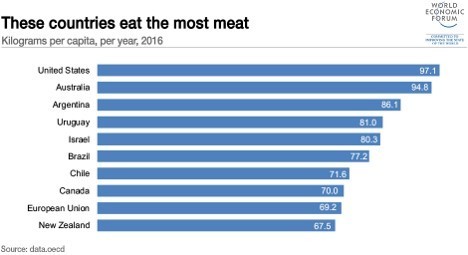These are the countries that eat the most meat

Red meat production is a major contributor to global warming because of the methane emitted by cattle and sheep. Image: REUTERS/Eric Gaillard

Get involved with our crowdsourced digital platform to deliver impact at scale
Stay up to date:
United States
The Organization for Economic Cooperation and Development (OECD) is keeping tabs on the world’s meat-eating habits, regularly publishing data showing which of its member countries are the most carnivorous.
The 2016 figures, taken from the OECD-FAO Agricultural Outlook 2017-2026, include the weights of beef and veal, pork, poultry and sheep consumed per capita, which are calculated based on kilograms of retail weight (the weight at which the meat is sold).

The United States tops the list, with citizens eating an average of around 97 kg per year.
Australia, which consumed the most meat according to the same data from 2013, is in second place, at 2.3 kg less per person per year than the US.
Australian meat consumption, however, has increased from 93 kg per person to 94.8 kg, the OECD data shows. Australians also consume far more lamb than their American counterparts – eating an average of 8.6 kg per person versus 0.4 kg in the United States.
Argentina is in third place at just over 86.1 kg per person per year. The South American country is also the second biggest consumer of beef and veal (38.6 kg), with first place being awarded to neighbouring Uruguay, where citizens consume on average 43.1 kg of red meat per year.
The carbon footprint of red meat
Red meat production is a major contributor to global warming because of the methane emitted by cattle and sheep.
Field-grown vegetables, on the other hand, produce the least emissions, according to research published in the Journal of Cleaner Production.
For example, it takes about 50 onions to produce a kilogram of greenhouse gas, but only 44 grams of beef to produce the same amount.

Lab-grown meat
Of course, it is plausible to substitute red meat with plant-based protein sources, such as lentils and nuts, that have a much smaller impact on the environment.
Or you could opt for an “Impossible Burger”, made by Impossible Foods, one of a handful of Silicon Valley start-ups creating “meat-free meat” that they claim looks, smells and even tastes like the real thing.

Apparently, the Impossible Burger’s authentic taste is all down to an iron-containing molecule called "heme", which Impossible Foods describes as the "magic ingredient that makes meat look, cook and taste gloriously meaty".
The company claims that by not using beef, one of its burgers uses 95% less land, 74% less water and reduces greenhouse gas emissions by 87%.
Don't miss any update on this topic
Create a free account and access your personalized content collection with our latest publications and analyses.
License and Republishing
World Economic Forum articles may be republished in accordance with the Creative Commons Attribution-NonCommercial-NoDerivatives 4.0 International Public License, and in accordance with our Terms of Use.
The views expressed in this article are those of the author alone and not the World Economic Forum.
Related topics:
The Agenda Weekly
A weekly update of the most important issues driving the global agenda
You can unsubscribe at any time using the link in our emails. For more details, review our privacy policy.
More on Industries in DepthSee all
Robin Pomeroy
April 25, 2024
Daniel Boero Vargas and Mandy Chan
April 25, 2024
Abhay Pareek and Drishti Kumar
April 23, 2024
Charlotte Edmond
April 11, 2024
Victoria Masterson
April 5, 2024
Douglas Broom
April 3, 2024






